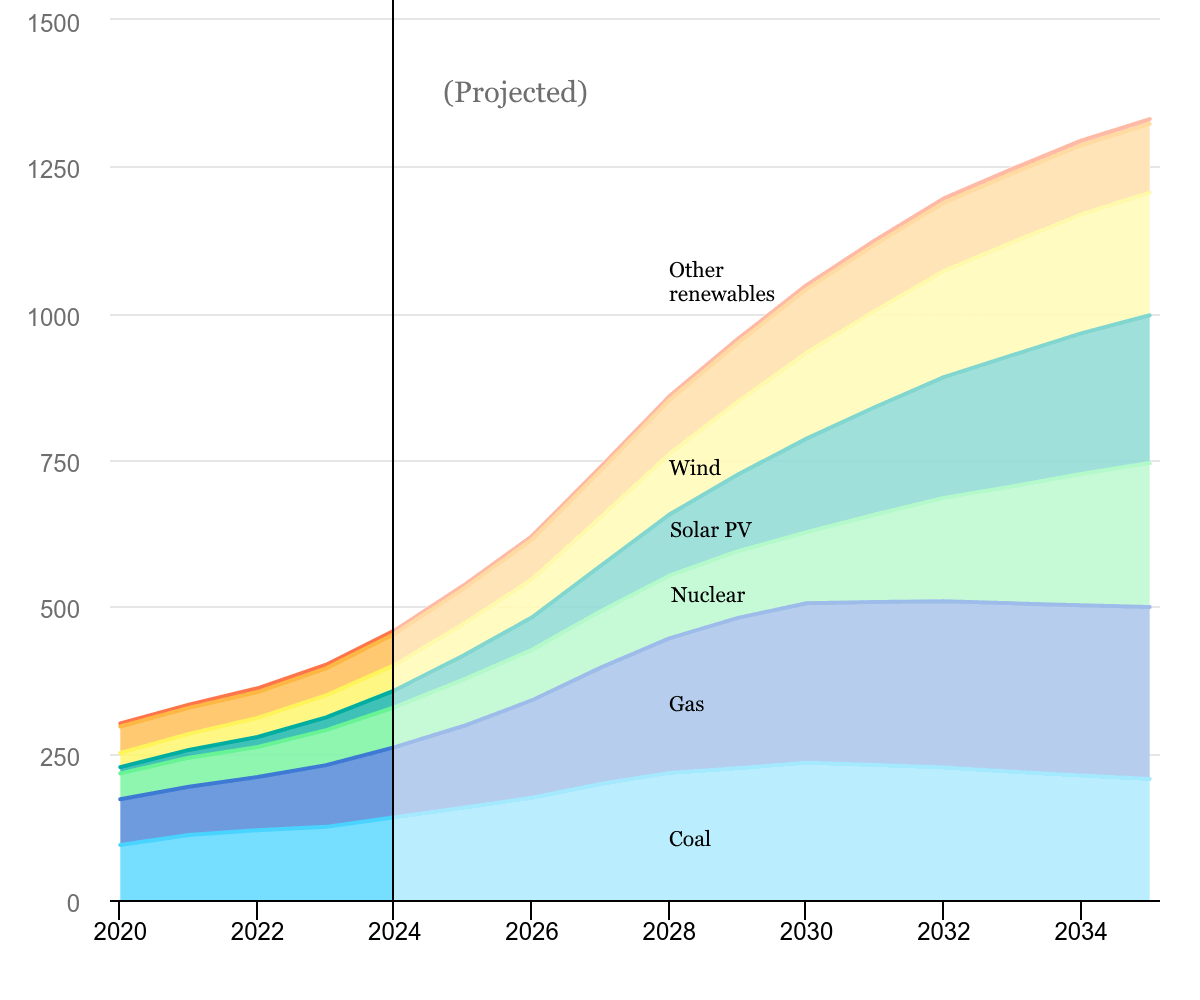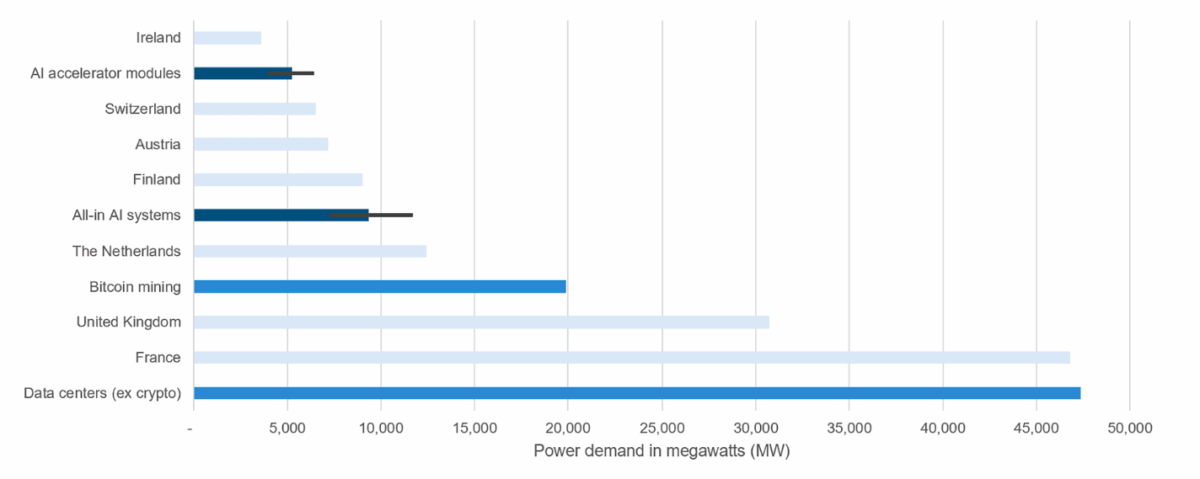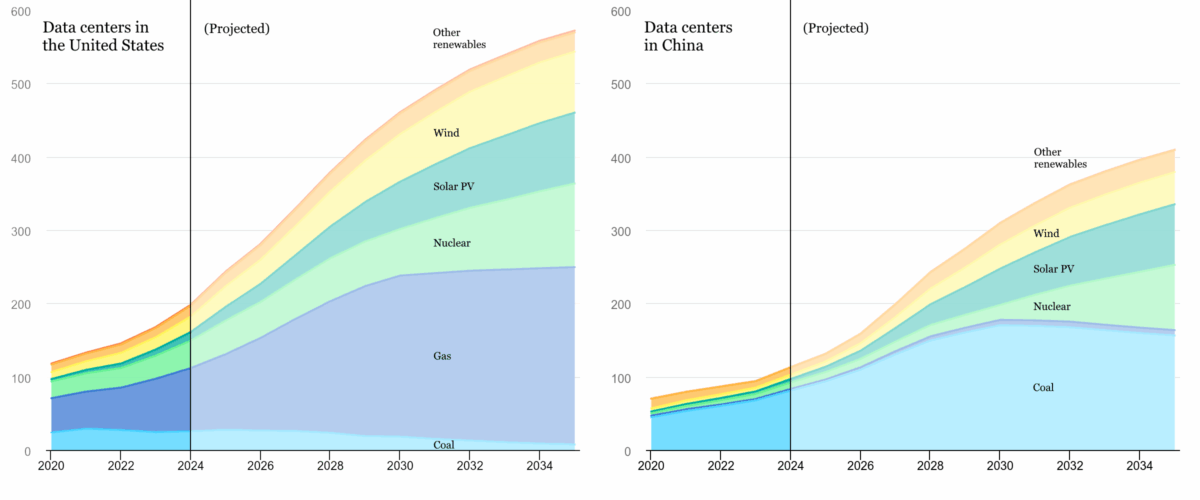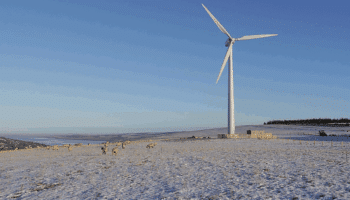- Energy
How much electricity do data centers use, and can they run on renewables?

Whenever you use ChatGPT, say, you interact with a type of computer facility called a data center. You aren’t alone – every second, data centers handle thousands upon thousands of ChatGPT users, plus billions of other Internet users all doing countless other tasks or storing countless bits of information.
Without data centers, the Internet would not exist as we know it. At the same time, data centers have faced growing environmental scrutiny – mainly for the amount of electricity they consume. Data centers take up a lot of electricity to keep the Internet running.
Today, our sources of that electricity are changing to include more intermittent solar and wind energy. Yet skeptics of renewable energy like to use data centers as evidence that ‘renewables don’t work’ – for example, stating that ‘data centers can’t run on renewables’.
So, how much energy do data centers actually use, and where does that power actually come from? Can solar and wind actually power them?
Main Takeaways:
- Data centers need a constant source of electricity. Data centers often run on solar and wind from the grid, but the intermittency of solar and wind means that it’s difficult to power data centers using these renewables alone.
- When data centers aren’t connected to the grid today, they’re often powered by diesel generators. However, a growing number of data centers are relying on solar and wind systems backed up by battery storage.
- Exact figures on data center electricity usage are difficult to find, because the tech companies who operate data centers don’t tend to release detailed statistics.
- The numbers we do have suggest that data centers consume about 1.5% of global electricity, and that this number is rapidly rising. It’s expected to reach 3 to 6% by 2030.
- However, data centers tend to be concentrated in particular places, like Virginia and Ireland. In these locations, they may account for a significantly higher proportion of a particular region’s electricity.
What is a data center?
When you interact with an online service – ordering food, reading news, watching a video, prompting ChatGPT – you’re likely interacting with a data center. Whenever you store information online – in your email, your social media, or in your cloud storage – you’re probably relying on one or more data centers.
Inside a data center, you’ll find racks of servers, network cables, and other computer equipment. Data centers may not look particularly glamorous, but without them, our tightly interconnected civilization would not exist. There are over 9,000 data centers in the world today, with many more in planning.
As you might imagine, all this equipment needs a great deal of energy. On top of the hardware itself, computers tend to generate quite a lot of heat, and data centers are no exception. Cooling is a major part of a data center’s electrical demands – as much as a third.
Like any computer, a data center can’t function without power. A 2024 survey by the Uptime Institute, an industry group, found that power outages were responsible for 53% of data center disruptions – more than hardware issues, software bugs, and cyberattacks combined.
Powering a data center, of course, is nothing like powering a home computer. A single data center can use tens of megawatts – the equivalent of an entire town.
So, where does this power come from?
Where do data centers get their electricity?
Many data centers are connected to their local grids. (As we’ll see later, these connections can add up.) They draw their electricity from the sources in the grid’s electric mix – whether fossil fuels, nuclear, or renewables.
The International Energy Agency (IEA) keeps count of where data centers’ electricity comes from. Today, just as coal and gas are the largest sources of electricity on grids worldwide, they’re the largest sources of power for data centers (Figure 1).

While many data centers are connected to the grid, others must rely on their own power sources, and many others use backup sources in the event of a power cut.
For the companies that run data centers, the economic benefits are so large that they’re willing to pay higher prices for a source of electricity they know will always provide power. Jonas Kristiansen Nøland, Professor of Electric Energy at the Norwegian University of Science and Technology, told Science Feedback:
“We see that reducing the capacity factor is a much, much, much bigger cost driver than paying more for electricity. These tech companies, they would rather have very expensive electricity, 24/7, rather than having cheap electricity here and there.”
This requirement places solar and wind, which do not always generate electricity, at a disadvantage. When a data center isn’t connected to the grid, it relies on its own backup sources. Today, these backups tend to run on diesel or gas.
However, it’s misleading to say that solar and wind can’t power data centers. For one, as we’ve said, solar and wind from the grid often provide data centers with a great deal of power (Figure 1).
Moreover, we now have the technology to back up solar and wind with batteries. This helps make intermittent renewables more reliable – when the solar panels or wind turbines are generating, the batteries charge up with excess power, which can be used when the sun isn’t out or the wind isn’t blowing. Some data centers now use battery systems.
Where do data centers get their electricity?
Calculating numbers like these is complicated by the fact that many tech companies and data center operators don’t release data on how much energy their data centers use[1]. Therefore, analysts must estimate data center electricity usage based on other factors, such as how many servers have been installed in particular data centers.
With that in mind, in 2023, the International Energy Agency estimated that data centers combined for 1 to 1.5% of the world’s electricity usage.
1.5% may not seem very high, but that number alone doesn’t tell the full story. Data centers aren’t evenly distributed everywhere. Instead, they tend to be concentrated in certain places, mostly near tech industry hubs. In such places, data centers can consume significantly more than 1.5% of local electricity.
For an example, we can look to ‘Data Center Alley’ in Virginia. This area has been a data center hub since the 1990s, and it’s said that 70% of the world’s Internet traffic flows through this small corner of the world (though Science Feedback could not identify the origin of this estimate). As a result, in 2023, data centers accounted for about 25% of Virginia’s total power load.
The European equivalent is the Republic of Ireland, where many U.S. tech companies have set up their European data centers. In 2023, data centers used 21% of the country’s electricity, according to Ireland’s Central Statistics Office.
Numbers this high are why some places around the world – for instance, the country of Singapore and the city of Amsterdam – have limited or outright banned new data centers. Elsewhere, utilities are hesitant or slow to add data centers to the grid. Even in Virginia, new data centers must now wait as long as seven years for a grid connection.
Moreover, we now know for sure that the electricity use of data centers is now dramatically surging.
Experts say AI is increasing data center electricity usage
For many years, data centers’ electricity usage stayed relatively flat. A 2020 study found that, between 2012 and 2018, the combined computing power of the world’s data centers increased by more than 550%, but their total energy use increased by just 6%[2]. Data centers became more and more efficient, making up for the boom in traffic they needed to handle.
The story since 2018 has been very different.
According to a 2024 report from Lawrence Berkeley National Laboratory in the U.S. – which combined numerous other reports – the world’s data center energy usage has more than doubled since 2018, with an even greater increase in the U.S. The rise in data center demand has drastically outpaced any improvements to efficiency.
What has changed? Experts say the answer is simple: AI. Alex de Vries-Gao, a PhD candidate at VU Amsterdam who has studied AI’s energy demands, told Science Feedback:
“you can really say that, without AI, we would be relatively flat, stable. But now AI is there and is really driving up data center electricity consumption. That’s how I think the trend is. Without AI, we wouldn’t have that much growth.”
What makes AI different is that cutting-edge AI models are trained and run on high-end chips, such as specialized GPUs. These chips are far more potent than their predecessors, but they’re also more power-hungry. Data centers designed for AI also tend to include more chips, more tightly packed together, which adds to a data center’s power demands.
Data centers have many uses aside from AI, and as we’ve said, actual hard data is not offered to the public. Without this, de Vries-Gao estimated AI’s share based on how many of the aforementioned chips have been been produced. His estimate suggests that AI already takes up about one-fifth of all data center power demand (Figure 2) – and that this number may rise to one-half within the next year[1].

Data centers are not only growing in number, they’re also growing in size. For example, we’re seeing a boom in so-called “hyperscaler” data centers, which are the largest – they need above 100 MW, enough electricity to power a modestly sized city.
All that means that we’re reaching a point where lack of power is becoming the major obstacle to expanding data centers. De Vries-Gao told Science Feedback:
“We don’t know to what extent this is really holding them back, because we still see a lot of data center buildout happening around the globe, but we do know that this is really becoming the primary bottleneck. The power demand that these companies have is huge.”
Jonas Kristiansen Nøland told Science Feedback:
“A decade ago, you had data centers of 10 MW. That was nothing compared to the existing grid. Now you see hyperscalers at 100 MW size, and now you see all the tech giants talking about data centers in the future of 1 to 5 GW. You could think about a data center in the future, one single data center, using more electricity than the entire country of Denmark.”
Another reason that computer emissions have increased is the rise of cryptocurrency mining. Acquiring new bits of a cryptocurrency like Bitcoin requires so-called “miners” to effectively solve complex puzzles. This is a very energy-intensive process, as miners often use powerful computers for their work. However, most counts of data center energy usage don’t include cryptocurrency.
What will power data centers in the future?
It’s quite hard to predict the future of data centers’ power demands with any degree of certainty. The lack of useful, transparent data means that it’s not very easy to actually tell what is happening in reality.
Even if we did have that data, AI is a fast-changing technology, and we don’t know what its future looks like. Masaō Ashtine, Senior Manager (Energy Transition) at the Carbon Trust, told Science Feedback:
“There are still many unknowns about how AI will reshape the data centre landscape, for better or worse. What we do know with certainty is that this topic demands immediate attention. Without it, we risk creating setbacks today that could compromise the resilience of our future energy systems and digital infrastructure.”
For example, we don’t know how long and how quickly AI will continue to boom. Large tech companies are readying hundreds of billions of dollars for data centers with AI in mind. If all their investments do play out, we’ll see many more data centers, and bigger ones than ever before.
On the other hand, experts question whether the current pace of rapid AI growth will actually continue for longer than a few years. Bob Burgoyne, Associate Director at the Carbon Trust, told Science Feedback:
“Honestly, I think the biggest unanswered question is whether a set of business case(s) will emerge that fundamentally justify the massive investment being made by all the different players in AI models or whether this will all be looked at as a bubble in a few years’ time.”
Additionally, predicting the future is always difficult. If you see an estimate, it’s worth taking it with a grain of salt – a 2022 review of 258 estimates in the previous 15 years found that less than a third came from peer-reviewed publications, and much of the rest lacked clear methodologies[3].
With that in mind, it’s perhaps unsurprising that the predictions we do have tend to vary. Higher-end predictions, assuming that data centers aggressively eat up loads of high-energy chips, say that data centers will consume as much as 6% of the world’s electricity and 12% of the U.S.’s by 2030. Others estimate as low as 2% and 7%, respectively.
In a fairly middle-of-the-road scenario, the IEA in April 2025 predicted that data centers will double again to 3% of global electricity consumption by 2030. 80% of that growth will happen in the U.S. and China alone.
The IEA also predicted what their electric mixes would look like. At first, data centers in both the U.S. and China will be fossil-fuel-dependent, as more and more data centers connect to both countries’ current grids. However, both the U.S. and China are adding large amounts of low-carbon electricity. The IEA estimates that low-carbon sources will provide of the majority of data centers’ electricity in both countries after 2030 (Figure 3).

In theory, data centers can actually support new renewable energy through deals such as power purchase agreements or PPAs – a purchaser agrees to buy low-carbon electricity from a future solar or wind farm. This gives the renewable energy source valuable funding in advance. Additionally, tech companies are funding the development of new types of nuclear reactors (also known as small modular reactors, or SMRs).
That said, it’s not yet clear whether these investments have made or will make a difference.
Furthermore, some scientists believe that the use of AI can make up for some of the electricity that data centers need by boosting renewables or increasing efficiency elsewhere in the economy. Anthony Harding, Assistant Professor of Economics at Georgia Tech, told Science Feedback:
“it is possible that AI technologies unlock improvements in energy efficiency or decarbonization, for example by facilitating greater integration of renewable energy technologies. How these two factors balance though is still yet to be seen.”
References
- 1 – de Vries-Gao, A. (2025) Artificial intelligence: Supply chain constraints and energy implications. Joule.
- 2 – Masanet et al. (2020) Recalibrating global data center energy-use estimates. Science.
- 3 – Mytton and Ashtine (2022) Sources of data center energy estimates: A comprehensive review. Joule.



